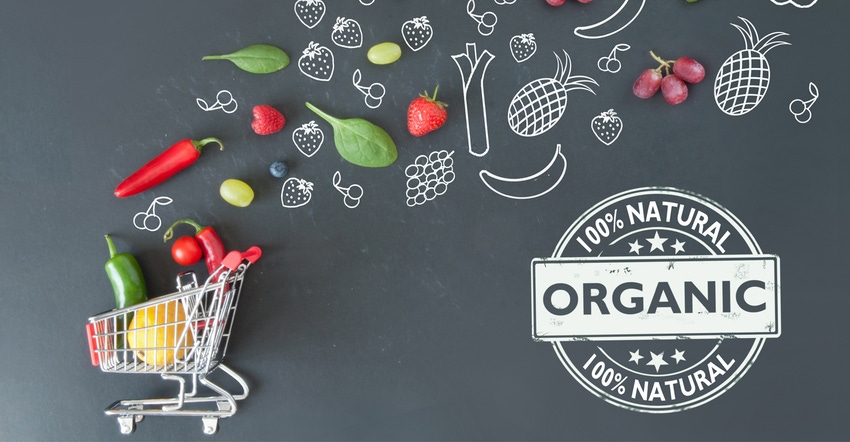Driven by consumer demand for high-quality clean, transparent and sustainable products from companies that embrace social activism, sales of organic food and non-food products shattered records and moved into mainstream markets in 2018, ringing up more than $50 billion in U.S. sales.

The U.S. organic market in 2018 broke the $50 billion mark for the first time, with sales hitting a record $52.5 billion, up 6.3 percent from 2017, according to the Organic Trade Association’s (OTA’s) 2019 Organic Industry Survey released May 17. New records were made in both the organic food market and the organic non-food market.
Organic food sales soared to $47.9 billion, an increase of 5.9 percent, while sales of organic non-food products jumped by 10.6 percent to $4.6 billion. The growth rate for organic continued to easily outpace the general market. In 2018, total food sales in the U.S. edged up just 2.3 percent while total non-food sales rose 3.7 percent.
According to the survey, Millennials are pushing for transparency and integrity in the food supply chain, and they are savvy to misleading marketing. The USDA Organic seal is gaining new appeal as consumers realize that organic is a certification that is monitored and supported by official standards, and is the only seal that encompasses the spectrum of Non-GMO, no toxic pesticides or chemicals, dyes or preservatives.
Market snapshot
Organic is no longer a niche market. Almost 6 percent of the food sold in the U.S., and organic products—food and non-food—can be found in every aisle of grocery stores. Organic products also are gaining shelf space in big box stores, club warehouse stores, convenience stores, and are increasingly sold on the internet.
“Organic is now considered mainstream. But the attitudes surrounding organic are anything but status quo,” said Laura Batcha, CEO and executive director, OTA. “In 2018, there was a notable shift in the mindset of those working in organic toward collaboration and activism to move the needle on the role organic can play in sustainability and tackling environmental initiatives.”
Produce continues to resonate with consumers
Organic fruits and vegetables retained its longstanding spot as the largest of all the major organic categories with sales of $17.4 billion in 2018 for a 5.6 percent rate of growth, on par with the growth attained in 2017. By comparison, the overall fruits and vegetables category, including both organic and conventional products, grew by just 1.7 percent in 2018.
Fruits and vegetables now account for 36.3 percent of all organic food sales. Organic fruits and vegetable make up 14.6 percent of all the produce sold in the U.S., and have nearly doubled their market share in the last ten years. This is key because produced is a gateway to organic for consumers, especially Millennials and those with young families. Industry experts note that the more people learn about health and wellness, the more people buy fresh produce. Best sellers in organic produce include carrots, greens, apples, bananas, berries, avocados, brussel sprouts, cauliflower and tropical fruits like mangoes and papayas. Outside the fresh produce section, the frozen, canned, and dried vegetable and fruit sections also made gains.
Innovation driving organic dairy market
Growth in the U.S. dairy sector slowed for the second straight year due largely to shifting diet trends; however, it is still the second-largest organic category. Dairy and egg sales were $6.5 billion in 2018, up 0.8 percent from 2017, with organic egg sales hitting $858 million, up 9.3 percent from 2017.
Consumers also are buying products higher in healthy fats and protein, and many Millennials have moved away from livestock-based products toward plant-based foods and beverages. To satisfy today's consumer, the importance of innovation in the organic dairy sector has never been greater. In 2018, the industry responded with milk beverages with increased protein, more full-fat dairy products, new flavors and grass-fed products.
Organic reaches far beyond food
Consumers also are seeking out organic non-food products such as household goods, pet foods, skincare and supplements. What’s more, Millennials have a higher awareness around supply chain transparency and sustainability.
Sales of organic non-food products increased 10.6 percent to hit $4.6 billion in 2018, well above the 7.4 percent growth rate reported in 2017, and the 3.6 percent growth rate reported in 2018 for the overall non-food industry (conventional and organic combined). The strongest growth came from fiber, the largest of the non-food categories, which accounts for 40 percent of the organic non-food market. In 2018, fiber recorded $1.8 billion in sales, up from $1.6 billion in 2017.
About the Author(s)
You May Also Like






.png?width=800&auto=webp&quality=80&disable=upscale)